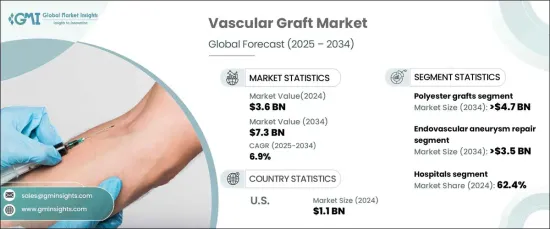
세계의 혈관 이식 시장은 2024년에 36억 달러로 평가되었고, 2025년부터 2034년까지 6.9%의 연평균 성장률(CAGR)을 기록하며 놀라운 성장을 보일 것으로 예상됩니다.
이러한 강력한 확장은 심혈관 질환의 유병률 증가, 말기 신장 질환(ESRD) 발생 증가, 외과적 개입 증가 등 여러 요인에 의해 주도되고 있습니다. 또한 혈관 이식의 기술 발전과 최소 침습적 시술로의 전환은 환경을 변화시키고 환자 결과를 개선하며 수술 솔루션을 더욱 접근 가능하고 효과적으로 만들고 있습니다.

세계의 의료 시스템이 인구 고령화와 이에 따른 만성 질환의 증가로 어려움을 겪으면서 혈관 이식에 대한 수요는 계속해서 급증하고 있습니다. 생체 공학 및 합성 이식 재료의 혁신은 생체 적합성, 내구성, 사용 편의성과 같은 중요한 과제를 해결하고 있습니다. 여러 재료의 장점을 결합한 하이브리드 그라프트도 수술 성공률을 향상시킬 수 있다는 점에서 주목받고 있습니다. 개인 맞춤형 의료에 대한 관심이 높아지면서 제조업체들은 다양한 의료적 요구에 맞춘 차세대 그라프트를 개발하기 위해 연구 개발에 투자하여 시장이 역동적이고 경쟁력을 유지할 수 있도록 노력하고 있습니다.
| 시장 범위 | |
|---|---|
| 시작 연도 | 2024년 |
| 예측 연도 | 2025-2034년 |
| 시작 금액 | 36억 달러 |
| 예측 금액 | 73억 달러 |
| CAGR | 6.9% |
시장은 원재료별로 폴리에스테르 그라프트, 발포 폴리테트라플루오로에틸렌(EPTFE) 그라프트, 생합성 그라프트, 폴리우레탄 그라프트로 구분됩니다. 폴리에스터 그라프트는 7.3%의 연평균 성장률로 2034년까지 시장 가치가 47억 달러에 달할 것으로 예상되는 등 지배적인 위치를 점하고 있습니다. Dacron과 같은 소재로 제작되는 이러한 그래프트는 특히 고압 혈관 환경에서 강도와 수명이 뛰어나다는 평가를 받고 있습니다. 대형 혈관을 수리하고 복잡한 심혈관 문제를 해결하는 데 광범위하게 적용되면서 시장 성장에 중요한 역할을 하고 있습니다.
용도별로 혈관 이식은 혈관 내 동맥류 치료(EVAR), 혈액 투석 접근, 말초 혈관 치료와 같은 시술에 활용됩니다. 이 중 EVAR은 2034년까지 7.7%의 연평균 성장률로 35억 달러에 달할 것으로 예상되는 등 괄목할 만한 성장세를 보일 것으로 전망됩니다. 절개 부위가 작고 회복 기간이 짧은 것이 특징인 이 최소 침습적 접근 방식은 기존의 개복 수술보다 점점 더 선호되고 있습니다. 합병증 위험이 낮아 고령자 및 고위험군 환자에게 이상적인 솔루션으로 전 세계적으로 도입이 크게 증가하고 있습니다.
북미의 혈관 이식 시장은 2024년 11억 달러에서 2025년부터 2034년까지 6.1%의 연평균 성장률(CAGR)로 성장할 것으로 예상됩니다. 이 지역은 스텐트 이식과 같은 특수 이식이 필요한 경우가 많은 EVAR을 비롯한 첨단 수술 기술을 수용하는 데 있어 선도적인 역할을 하고 있습니다. 최첨단 의료 기술의 광범위한 채택과 잘 구축된 의료 인프라로 인해 북미는 글로벌 혈관 이식 시장에서 혁신과 수요의 핵심 동인으로 자리매김하고 있습니다.
The Global Vascular Graft Market, valued at USD 3.6 billion in 2024, is set to witness impressive growth, with a projected CAGR of 6.9% from 2025 to 2034. This robust expansion is driven by multiple factors, including the escalating prevalence of cardiovascular diseases, rising occurrences of end-stage renal disease (ESRD), and increasing surgical interventions. Furthermore, technological advancements in vascular grafts and the shift toward minimally invasive procedures are transforming the landscape, enhancing patient outcomes, and making surgical solutions more accessible and effective.

As healthcare systems worldwide grapple with aging populations and the associated rise in chronic conditions, the demand for vascular grafts continues to surge. Innovations in bioengineered and synthetic graft materials are addressing critical challenges such as biocompatibility, durability, and ease of use. Hybrid grafts, which combine the strengths of multiple materials, are also gaining traction for their ability to improve surgical success rates. With a greater emphasis on personalized healthcare, manufacturers invest in research and development to create next-generation grafts tailored to diverse medical needs, ensuring the market remains dynamic and competitive.
| Market Scope | |
|---|---|
| Start Year | 2024 |
| Forecast Year | 2025-2034 |
| Start Value | $3.6 Billion |
| Forecast Value | $7.3 Billion |
| CAGR | 6.9% |
The market is segmented by raw material into polyester grafts, expanded polytetrafluoroethylene (EPTFE) grafts, biosynthetic grafts, and polyurethane grafts. Polyester grafts are positioned to dominate, with an anticipated CAGR of 7.3%, driving their market value to USD 4.7 billion by 2034. These grafts, often constructed from materials like Dacron, are lauded for their strength and longevity, particularly in high-pressure vascular environments. Their widespread application in repairing large vessels and addressing complex cardiovascular challenges highlights their critical role in the market's growth.
By application, vascular grafts are utilized in procedures such as endovascular aneurysm repair (EVAR), hemodialysis access, and peripheral vascular repair. Among these, EVAR is poised for remarkable growth, with a projected CAGR of 7.7%, reaching USD 3.5 billion by 2034. This minimally invasive approach, characterized by smaller incisions and shorter recovery periods, is increasingly favored over traditional open surgeries. Its reduced risk of complications makes it an ideal solution for elderly and high-risk patients, significantly boosting its adoption globally.
In North America, the vascular graft market is projected to grow at a CAGR of 6.1% from 2025 to 2034, starting at USD 1.1 billion in 2024. The region remains a leader in embracing advanced surgical technologies, including EVAR, which often necessitates specialized grafts like stent grafts. The widespread adoption of cutting-edge medical techniques and a well-established healthcare infrastructure position North America as a key driver of innovation and demand within the global vascular graft market.